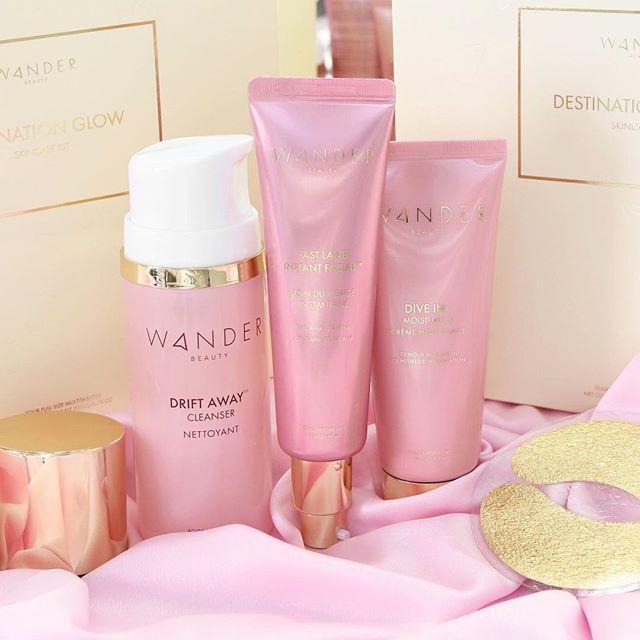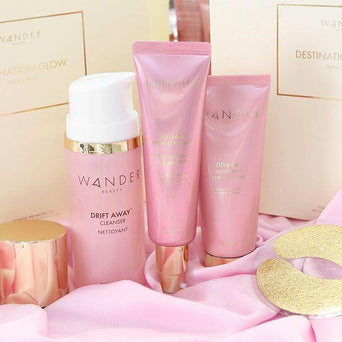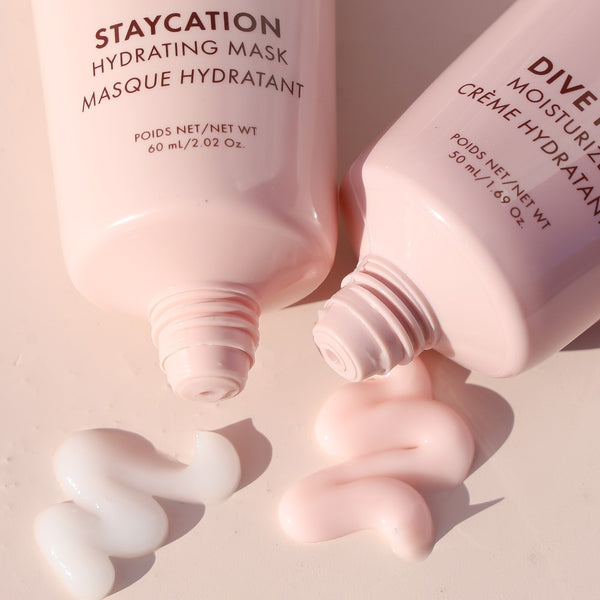Skincare Alphabet Soup: The Ultimate Guide to Understanding The Ingredients In Your Favorite Products
By Emily Chiang | Nov 22, 2021
The alphabet seemed simple... until the beauty world got a hold of it. Does it ever feel like shopping for skincare requires learning a whole other language? Us too. Luckily, you don’t have to worry about drowning in alphabet soup! We’re here to break down the series of letters found in your beauty products.
AHA
AHA stands for alpha-hydroxy acids. These are made up of tiny molecules of water-loving and water-soluble acids. Perfect for our Wander Beauties who want more youthful looking skin, AHAs, when properly formulated in beauty products, work to exfoliate the skin’s surface, revealing skin that appears more hydrated, smoother, and becomes visibly firmer over time. Many AHAs are derived from fruits, milk, sugars, or nuts and are great for stimulating collagen production.
Some of the most commonly used AHAs in beauty products are:
Glycolic acid: This acid has the smallest molecules which allows it to penetrate deeply into skin. It helps to reduce fine lines, wrinkles, acne, blackheads, dullness, controls sebum production, etc.
Lactic acid: This acid helps to soften skin, reduce fine lines, hydrates, inhibits pigment, adjusts pH, improves skin texture, rids of dead skin cells, etc.
Malic acid: Helps to improve skin’s texture and appearance, tighten pores, minimize skin pigmentation, reduce wrinkles, exfoliate old skin, increase tissue respiration, hydrates, and soothes.
Mandelic acid: This acid is gentler than glycolic acid because its molecules are twice as big, so it takes longer for it to penetrate skin and is therefore less likely to cause irritation. It helps to control pigmentation, reduce fine lines and wrinkles, improve acne, increase collagen production, gets rid of dead skin cells.
Tartaric acid: This acid helps to smooth skin, improve skin texture, enhances your skin’s natural glow and more.
Often when AHAs are found in a product’s ingredient list, they are there to act as a chemical exfoliant. They are working with other ingredients to break down dead skin cells at the uppermost layer of skin. They help to improve acne scarring, improve the appearance of uneven skin tone and texture, gives skin firmness and smoothness, etc. AHAs are a powerhouse for achieving more youthful looking skin.
BHA
BHA stands for beta-hydroxy acids. They are acids that are great for treating blackheads and white heads. BHAs, which have anti-inflammatory and antibacterial properties, are able to help unclog pores and stabilize the lining of the pore that contributes to acne. Many BHAs are derived from sweet birch and willow bark.
One of the most common BHAs is salicylic acid. Salicylic acid is a fat-soluble which gives it the ability to penetrate deep into pores and clear out excess debris. It helps calm down general redness and inflammation
Often when BHAs are found in a product’s ingredient list, they are used to fight acne and calm skin inflammation. These acids are perfect for treating acne prone skin as well as blackheads and whiteheads.
Keep in mind that when using AHAs and BHAs, your skin becomes more vulnerable to the sun, so remember to use SPF when treating your skin. PSA Wander Beauties: you should wear sunscreen every day to prevent damage from UVA rays. Regardless of whether or not you can see the rays, you should take caution against these invisible rays to prevent burning of the skin, age spots, as well as skin cancer.
GLA
GLA stands for gamma linolenic acid. It is a fatty acid found in cosmetics that are used as an antioxidant and emollient. It is found in various plant seed oils such as evening primrose oil and borage oil.
SLS
SLS stands for sodium lauryl sulphate. It is commonly known as a “surfactant” which means it breaks the surface tension of water and separates molecules from one another, which creates foam or lather on the skin. There are many mixed opinions about this ingredient because it can be sensitizing for your skin and it can become carcinogenic if mixed with other chemicals.
SPF
SPF stands for sun protection factor. It is a measure of how well a sunscreen will protect your skin from UVB rays, which is what causes sunburn and contributes to skin cancer.
Want to learn more about the beauty world language? Let us know what series of letters you would like us to decode @wander_beauty!
Skincare Alphabet Soup: The Ultimate Guide to Understanding The Ingredients In Your Favorite Products

The alphabet seemed simple... until the beauty world got a hold of it. Does it ever feel like shopping for skincare requires learning a whole other language? Us too. Luckily, you don’t have to worry about drowning in alphabet soup! We’re here to break down the series of letters found in your beauty products.
AHA
AHA stands for alpha-hydroxy acids. These are made up of tiny molecules of water-loving and water-soluble acids. Perfect for our Wander Beauties who want more youthful looking skin, AHAs, when properly formulated in beauty products, work to exfoliate the skin’s surface, revealing skin that appears more hydrated, smoother, and becomes visibly firmer over time. Many AHAs are derived from fruits, milk, sugars, or nuts and are great for stimulating collagen production.
Some of the most commonly used AHAs in beauty products are:
Glycolic acid: This acid has the smallest molecules which allows it to penetrate deeply into skin. It helps to reduce fine lines, wrinkles, acne, blackheads, dullness, controls sebum production, etc.
Lactic acid: This acid helps to soften skin, reduce fine lines, hydrates, inhibits pigment, adjusts pH, improves skin texture, rids of dead skin cells, etc.
Malic acid: Helps to improve skin’s texture and appearance, tighten pores, minimize skin pigmentation, reduce wrinkles, exfoliate old skin, increase tissue respiration, hydrates, and soothes.
Mandelic acid: This acid is gentler than glycolic acid because its molecules are twice as big, so it takes longer for it to penetrate skin and is therefore less likely to cause irritation. It helps to control pigmentation, reduce fine lines and wrinkles, improve acne, increase collagen production, gets rid of dead skin cells.
Tartaric acid: This acid helps to smooth skin, improve skin texture, enhances your skin’s natural glow and more.
Often when AHAs are found in a product’s ingredient list, they are there to act as a chemical exfoliant. They are working with other ingredients to break down dead skin cells at the uppermost layer of skin. They help to improve acne scarring, improve the appearance of uneven skin tone and texture, gives skin firmness and smoothness, etc. AHAs are a powerhouse for achieving more youthful looking skin.
BHA
BHA stands for beta-hydroxy acids. They are acids that are great for treating blackheads and white heads. BHAs, which have anti-inflammatory and antibacterial properties, are able to help unclog pores and stabilize the lining of the pore that contributes to acne. Many BHAs are derived from sweet birch and willow bark.
One of the most common BHAs is salicylic acid. Salicylic acid is a fat-soluble which gives it the ability to penetrate deep into pores and clear out excess debris. It helps calm down general redness and inflammation
Often when BHAs are found in a product’s ingredient list, they are used to fight acne and calm skin inflammation. These acids are perfect for treating acne prone skin as well as blackheads and whiteheads.
Keep in mind that when using AHAs and BHAs, your skin becomes more vulnerable to the sun, so remember to use SPF when treating your skin. PSA Wander Beauties: you should wear sunscreen every day to prevent damage from UVA rays. Regardless of whether or not you can see the rays, you should take caution against these invisible rays to prevent burning of the skin, age spots, as well as skin cancer.
GLA
GLA stands for gamma linolenic acid. It is a fatty acid found in cosmetics that are used as an antioxidant and emollient. It is found in various plant seed oils such as evening primrose oil and borage oil.
SLS
SLS stands for sodium lauryl sulphate. It is commonly known as a “surfactant” which means it breaks the surface tension of water and separates molecules from one another, which creates foam or lather on the skin. There are many mixed opinions about this ingredient because it can be sensitizing for your skin and it can become carcinogenic if mixed with other chemicals.
SPF
SPF stands for sun protection factor. It is a measure of how well a sunscreen will protect your skin from UVB rays, which is what causes sunburn and contributes to skin cancer.
Want to learn more about the beauty world language? Let us know what series of letters you would like us to decode @wander_beauty!



